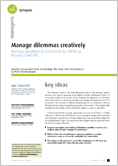Take responsibility for change

To make things change, we have a lot more leeway than we think. How can we take responsibility for creating the changes we want to see implemented?
In professional life, the reasons for frustration abound. Who has never felt trapped by a rigidified system? Who has never complained about colleagues’ behavior, the impossibility to change things, or the extent of changes required for real progress to happen? A natural reflex is to adopt a fatalistic, passive, or even defeatist attitude. After all, why even bother trying if everything seems to indicate that nothing will come of it? That’s why, out of ten smokers who say they want to quit smoking, seven have actually never tried, while an average of six attempts is generally needed to quit for good! It’s also why many managers give up on the idea of encouraging their subordinates to take more initiative, convinced that it would do no good.
In fact, observation of successful change shows that adopting a different attitude is often the key to success. We actually have much more wiggle room than we imagine; it’s up to us to take advantage of it! “Be the change you wish to see in the world,” said Gandhi. It is amazing to note that merely deciding to play an active role in change can be sufficient to make it happen.
Three recommendations are helpful in this regard:
- Assume responsibility for desired changes. Taking action at your own level is often sufficient to create a first beneficial impact, and ultimately trigger change of greater magnitude.
- Pace yourself. Change is truly successful only if it is maintained over time. You are better off focusing on small actions that have an impact and saving your energy than exhausting yourself trying to do too much.
- Watch out for reflexes connected to the environment. A simple modification of the situation in which you’re operating can have a major impact in facilitating change.
SubscriberSign in
to download
the synopse (8 p.)
VisitorI want to buy
this synopsis (8 p.)
VisitorI want
to subscribe
See also

Contradictions, a source of innovation?
Great leaders are able to surmount apparent contradictions to devise original solutions that bridge the two initial options. How can you draw inspiration from their example to turn dilemmas into a source of creativity?

